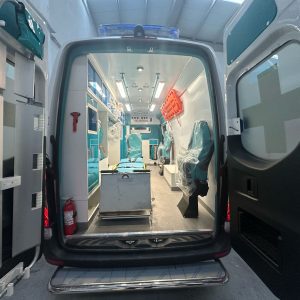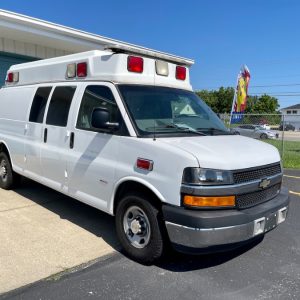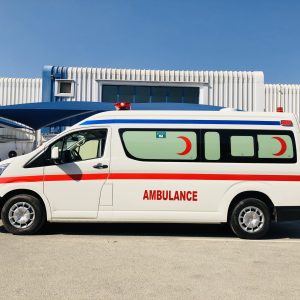1. Introduction to Mobile Health Vehicle
Mobile Health Vehicle; Affordable access to basic medical services is still not available or is difficult to access in several remote areas in today’s developed or developing nations. To address this critical issue, several health personnel, practitioners of medical care, social workers, and mobile health units (MHUs) are working together with the support of public-private partnerships and other stakeholders. These groups further work in global vaccine delivery initiatives and grant funding to bridge the gap in accessibility and to promote good health conditions on a global scale. Rural and remote populations face diverse challenges in medical care or accessible health services due to geographical reasons, which are often not available within their territorial boundaries. To ensure accessible healthcare for people in rural and urban work environments, physicians use MHUs with supporting hardware, standards, and technology within a well-planned integrated people-centric system that also supports the framework for people-centered and integrated healthcare services and upholds the dignity of patients.
1.2. Movement Mobile health services are now increasingly becoming a necessity. For example, mobile healthcare is gaining attention in developed countries to provide services for people in remote areas or to offer emergency services during events. It must function in accordance with the patient’s cultural and linguistic requirements. In developing countries, the structure of healthcare is such that the government needs buses that can provide health services to rural and urban areas where there is a scarcity of health services and doctors. These systems include diagnostic equipment, air conditioning, refrigeration, generators, internet, telephone systems, and water facilities. These buses can be deployed with doctors and supervisory staff for rural and slum areas. All diagnostic equipment can operate in the bus through either battery or generator power. These buses are driven by professional nursing and medical staff, who work in conjunction with medical first responders, such as emergency medical personnel from hospitals or social workers from local health departments. A survivor from such a disaster could receive five levels of care, including up to six hours in the mobile field hospitals before being moved to a longer-term facility.
2. Design Considerations in Mobile Health Vehicle Manufacturing
This section discusses the design considerations in the manufacturing of mobile health vehicles. Ideally, these vehicles must provide an ergonomic workspace for healthcare providers so that the service can be provided most effectively. They must accommodate workspace, high-tech medical equipment, plumbing and electrical systems, and the mobility needs of the patients. Clean water and wastewater systems must be integrated to complete a full-service capability. In addition to the essential requirements for functionality, considerations on medical equipment integration into small confined spaces are discussed, as well as the need for compliance with health and safety regulations. Aesthetics and psychological factors have also been added to the requirement, proving that appearance has an effect on the patients’ and staff’s perception, and thus the healing process and effective working.
Critical design elements that must be considered in the manufacturing of comprehensive mobile healthcare units are space for the medical equipment, equipment layout to provide correct ergonomic and efficient workspaces for the healthcare provider, and the patient environment that is comfortable and user-friendly. Mobile healthcare vehicles need to accommodate a variety of complex high-tech medical devices and filing systems. Mobile healthcare vehicles should have the same professional look as a classic healthcare facility, but it is preferable that the vehicles have an ‘attractive friendly’ feeling towards the users. The design of the medical vehicle is a valuable asset in generating this first-hand feeling for the user and helps to create an empathic brand image for the healthcare practice that can be expressed in many ways. The more liberal interpretation of the guidelines, dimensions, and values, such as flexibility in terms of the approach to any engineering solutions or exchangeability in the recommendations.
3. Technological Advancements in Mobile Health Vehicle
Central to the success of mobile health units are their smart technology solutions, which enable rapid patient and customer service. With increasing technological advancements, the nature of patient care within mobile health units has greatly evolved. Various diagnostic tools enable primary care centers to practice a wider range of medicine today and are now available in miniaturized form. Basic dermatological equipment, such as dermatoscopes, can easily be implemented in the mobile health infrastructure to study suspicious skin lesions. Different types of ECGs use sensors employed on various spots on the body. Other portable devices cover ultrasound equipment, cardiac echo Doppler studies, and coagulation devices. X-ray machines are entirely redesigned since bulky X-ray films are no longer needed, and imaging immediately appears on screens and is stored digitally. New technologies have enabled remote monitoring and telemedicine through telephonic communication with patients.
Mobile health units can greatly benefit from the use of remote monitoring and digital monitoring technology. The 5G connection can further improve the technological capabilities of mobile health units. This feature can help in smooth connection with the central server while on the move. Several software implementations have evolved to improve the smooth operation of quality care in mobile health units. Complete electronic health records of patients are very helpful to track special services. In addition, software can be used for various other management-related services such as information, planning, and reporting. There are many diagnostic and therapeutic capabilities on wheels today. The treatment facility is also augmented with various types of medical equipment kept in a mobile health care vehicle. Ultra-portable laboratory devices are fully automatic and can quickly test blood from a small droplet. Urology treatment often requires an analysis of urine, blood, or cystoscope tests, which can be done in mobile health units using digital remote analysis with small medical devices. Furthermore, the analytical techniques applied to the dissolved biosamples can completely distinguish them from other substances dissolved in the same medium and are quite specific in nature, which can avoid any ambiguity in the presence of other anions, eliminating any limitations and practical requirements, among other things. These techniques render the proposed system a step forward in the point-of-care diagnostics setup. With the installation of proper hygienic solutions, the life of such accomplished devices can be quite good. Sustainable technologies, including solar panel systems, have been integrated since the early years of mobile health vehicles to promote environmental and cost-saving benefits. More than 3,500 mobile health unit components have been developed for mobile unit operation with these sustainable solutions, with many in use since the 1970s. Mobile health unit availability today is greatly improved by the addition of IoT. With mobile health designs incorporating the latest technological advancements, technology has greatly shaped the mobile health vehicle availability in industries.
4. Case Studies of Successful Mobile Health Vehicle Programs
In this paper, we provide selected case studies of successful mobile health vehicle programs that can serve as best-practice benchmarks and inspire others to begin or expand similar programming. Each case study describes the population and diseases targeted, the presentation of the vehicle program, and selected outcomes, evaluations, or lessons learned. We found that these vehicles are used for immunization drives, out-of-catchment services, primary healthcare, patient and training referral, and acute response to public health threats. As with the case studies in the more comprehensive book, these interventions demonstrate some early benefits or at least some powerful lessons about what does not work in the field. What is most important is that empirical evidence such as this shows that MVP goals can be met and that integrated programming, such as the proposed health vehicle extensions, can make an impact and should be more widely pursued.
K-Mobile, Kauri Center; Lao PDR Partnership: Basic services project in Sepon Nui, Vilabouly, Sepone, Chape, and Phouvong district, Savannakhet province, Lao PDR, and the Sepon mine area. This four-year project was launched in January 2003 and aimed to support improvements in rural areas of education, basic health services, water supply and sanitation, food security, and livelihood development, addressing HIV/AIDS and STIs, in order to support long-term development. The project set about achieving these through partnerships with existing government structures and a company that runs a copper mine in the area. The project’s major achievements have been in education, disability support, clinic, and referral systems. The company suggested a mobile van to reach miners (it also benefits local people) and was built and run by the project from 2004. The van cost for the build and for equipment, and runs annually at an operational cost. Host communities were 25 kilometers or further from any health facility before the van commenced. The van attends between five and 15 sites (including mine sites) weekly and attends Sepon College of Education twice yearly to provide sexual health education and information. Services include maternal and child health, first aid, family planning and sex education, immunization, acute illness, communicable disease control, and referrals. Staff include one driver, a male consultant, and sometimes a female health worker or specialist doctor. The population reached by the van is 1,332, with about 40 percent attendance by young adults and older kids. This is a good example of sharing best practices through inter-agency communication. The K-Mobile van was researched to gain best practice design and service delivery techniques.
5. Impact of Mobile Health Vehicles on Healthcare Accessibility and Outcomes
Mobile health vehicles of all unit types and purposes make a profound impact on healthcare-related issues of access and utilization by serving as vital links for many of our nation’s and world’s most medically and economically underserved populations. For children and adults of all ages and socioeconomic statuses, units provide unique, cost-effective interventions, preventive services, and/or follow-up and treatment plans for multiple chronic conditions and infectious diseases. Not only can some of the most vulnerable patients receive a range of services second only in scope and variety to those offered within the four walls of the stationary healthcare facility, but they can also, in many cases, access a level of care that is facilitated and co-participatory with members who live and work in the communities of these patients. Through this co-participatory dimension, friendly patient engagement, and family involvement, the use of the units often becomes a gateway or bridge to success-oriented healthcare behavior adoption and access to the traditional medical home.
In mobile health or clinical services, care delivery and associated healthcare include medication management, which together are made available from inside an appropriately operated vehicle that is proven to foster the desired patient experience. The barriers and economic implications already described for program entry are also long-standing in our current healthcare delivery system when patients and their families face numerous challenges to establish and maintain a consistent and long-term medical home. Innovations resulting in the use of units have clearly demonstrated the ability to increase health equity by reaching and subsequently improving health outcomes for young children, older adults, and others who have difficulty engaging or do not engage in the traditional delivery of primary or mental healthcare services. Modest community movements toward citizen acceptance and receptivity to units and their programs occur over time as units and staff actively engage in establishing trust and promoting patient buy-in, comfort, and satisfaction. Adopting a mobile vehicle-based strategy faces initial challenges, but further links healthcare resources and local agencies and is capable of improving long-term population health.













